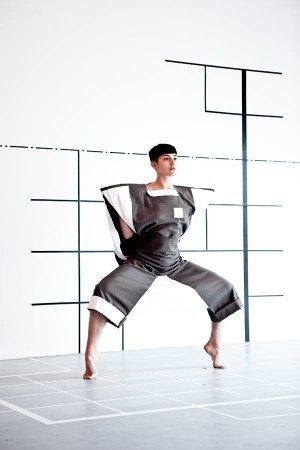You have no items in your cart. Want to get some nice things?
Go shopping
Although not a new concept in fashion, gender fluidity is finally finding its place in retailers. Labels such as Gucci and Yves Saint Laurent have previously used male models for female-directed clothes and vice versa, but now with the rise of campaigns supporting and providing gender fluidity in fashion, such as Selfridges ‘Agender’ and The Corner’s ‘No Gender,’ how does the future of genderless fashion look? We spoke to Gabriel Ann Maher and Uta Brandes to shine a light on fashion to come. Maher, a designer, focuses on the relationship between body and structure with an interest in objects and systems, and is also interested in questioning design practices through queer and feminist frameworks. Design expert Brandes of Be Design, is a professor of Gender and Design and of Design Research at the Koeln International School of Design.
Litro: ‘How do you feel the fashion and design scape has changed with the introduction of gender-neutral clothing in fashion, if so?’
Gabriel Ann Maher: ‘Introducing gender neutral into the mainstream fashion landscape perhaps does several things. First it explicitly acknowledges that separations between M and F clothing is an overly dominant principle of retail and the fashion system and seeks to show an alternative. Neutral acknowledges positions beyond binaries and in that sense it opens to many more possibilities for fashion and ways of thinking. It would be very interesting to see how the physicality of the industry has shifted with the introduction of neutral – patterns, cuts and colours.’
Uta Brandes: ‘Beforehand: I state that there is no “gender neutrality”: everybody (By the way: “every BODY”, “no BODY”, “some BODY” is emphasizing the corporeality of individuals!) – everybody is gendered, in what way ever; we cannot not escape the empirical reality of gender. Gender-sensitivity is the term I would like to suggest. As fashion is a precise seismograph of new trends and tendencies not only regarding clothing but often serves as an overall social ‘blueprint’, it certainly can be of importance for societal visions and anticipations.’
Selfridges recent 6 week creative project, ‘Agender,’ notes a shift in fashion and in consciousness regarding gender-fluidity. The space was comprised of three floors of gender-neutral clothes, a genderless environment void of brands, labels and directives. Selfridges creative director Linda Hewson commented in their press release, ‘Agender is one of our most highly anticipated fashion projects to date. With each of our creative schemes, our aim is to inspire and challenge our customers and open a conversation. We want to explore ideas and make them accessible and relevant to a diverse demographic. We also want to challenge our own understanding of retail, and contemplate the future of shopping at Selfridges. Through Agender, we’ve changed the context of shopping in store and online; by removing gender codes, our shoppers will be free to make choices based purely on personal taste.’
We asked Brandes and Maher about the ‘Agender’ campaign;
Litro: ‘Selfridges ‘Agender’ campaign was a great success, do you think will we see more gender-neutral fashion in high street stores?’
Uta Brandes: ‘This is difficult to evaluate: either it may be the forerunner for more mainstream fashion or it is just another fancy marketing concept that may soon be replaced by the next action. I am afraid it is just a new marketing gimmick.’
Gabriel Ann Maher: ‘Yes I imagine. And as diversified understandings of gender identity gain further visibility, the concept will be explored much further and in a more nuanced way. We are used to the structure of separations between M and F clothing so it’s very necessary to have those boundaries shifted first by the idea of gender neutral and then to go even deeper. Neutral is maybe a first step towards challenging the language of fashion at a mainstream level.’
Now online retailer The Corner is making their move into selling gender-sensitive fashion. Their upcoming ‘No Gender’ space, they insist, is not a fad. ‘Far from a fad, the “No Gender” section stems from a strong request from global fashion consumers for a new type of approach that goes beyond the traditional gender divide. Far from theatrical, the assortment will reflect a thoroughly modern way of dressing, equally influenced by street culture as by sartorial classics; a direct response to a very contemporary taste coupled with a strong yearning for timeless style.’ I want to briefly pause on their statement ‘far from theatrical.’ It highlights the assumptions and preconceived ideas people still hold about gender, that any forms of ‘unconventional’ gender constructs are an act, a performance.
As of yet it appears that the move into genderless clothing has been made solely by high-end fashion, and is yet to be followed by high street retailers. American Apparel have sold ‘unisex’ clothing for years, however high street shops are yet to answer to the want for genderless clothes. We asked whether gender-neutral clothing will take the place of male and female gender-directed clothes in the near future;
Uta Brandes: ‘Gender-sensitive clothing will be one trend among others. If you carefully observe, fashion currently is harshly divided into two diametrically opposed impulses: androgyny clothing on the one hand, overemphasised binary sexual clothing on the other. ‘
Gabriel Ann Maher: ‘Not necessarily. I imagine that the approach will become more nuanced and diversified; gender neutral, or queering of fashion codes in general will become more widely known and appreciated. See the following brands: ASSK and Hood by Air featuring Boychild The concept of Masculine and feminine directed clothing will still be important to many, including trans and genderqueer/diverse identified individuals, however the significations might shift from traditional to more of an assemblage / mixing of codes. We will not be too quick to assume someone’s gender identity based on traditional fashion codes, which i think is interesting and necessary. the codes of masculine + feminine + neutral + queer becomes more playful, less restricted at the level of the department store and physical expression in social spaces. Not take the place of.’
The forwarding of gender-sensitivity, to use Brandes’ term, by celebrities such as Caitlyn Jenner and Jaden Smith, and retailers such as Selfridges, alongside the dominant role that media plays in relaying their choices and beliefs, encourages new thought, new ideas and ideals for people to consider. Sixteen year-old Jaden Smith is known for dressing in female-directed clothes, becoming a praised fashion icon for his ‘unconventional’ mode of dress, as it has been labelled. But will the word ‘unconventional’ be cast aside soon? Because what actually is conventional? The same as everyone else? Is our obsession with convention due to our fear of the unknown, the ‘abnormal?’ It is exciting that the previously clear and rigid gender divisions are being blurred. Maher wrote in regards to his DE_SIGN series, ‘We take visual cues from the clothed body, which are heavily imbued with social and cultural meaning. When we read and encode the clothed body with gendered meaning, the body is formulated as a consequence. Within this formula the body is divided into left and right, front and back and it is layered. Gendering is triggered by deconstructing and signifying key sections of the body. These sections engender and de gender parts of the body through extension and reduction.’
Litro: ‘From your research, have you ascertained how the general public feel about gender-neutral design? Has it received a positive response? I hope so!’
Gabriel Ann Maher: ‘I think in a general sense it is very interesting for a general public. The aesthetic is quite easily pleasing and creates points of interest as well as sparks dialogue in a general public. The response on the whole is a positive one. Whether or not the style is adopted quickly by a general audience as a wearer is another story.’
Uta Brandes: ‘First of all, this truly is a generational issue: the majority of younger teenagers explicitly express their gender (even sex); younger adults are highly interested in gender-sensitive/gender-blur/androgynous fashion; older people are confused and tend to oppose it. – It will be exciting to see what the future may hold: regression into conventional-conservative patterns, androgynous fashion, or an even more radical openness: everything is possible: the most fluid and elastic constructs of expressing different and changing gender identities – this is my favourite concept!’
‘Everything is possible’ is highly exciting.

About Isabel Gonzalez-Prendergast
Isabel is particularly interested in international literature, learning about different cultures and philosophies.




The aesthetic is quite easily pleasing and creates points of interest as well as sparks dialogue in a general public. The response on the whole is a positive one. Whether or not the style is adopted quickly by a general audience as a wearer is another story.
This is good
I love martial arts myself but I also get scared myself whenever I see people doing some kick ass moves. It makes me dizzy, really dont know how they handle this.